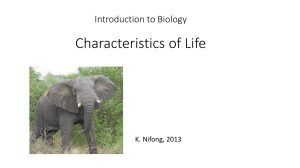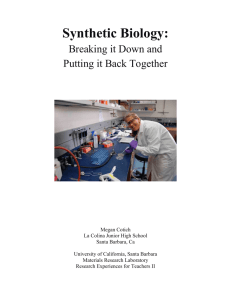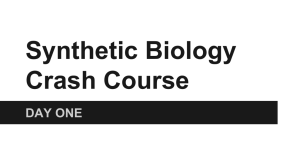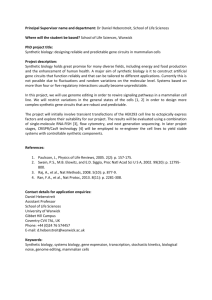2. Synthetic Biology Lesson Plan.doc
advertisement
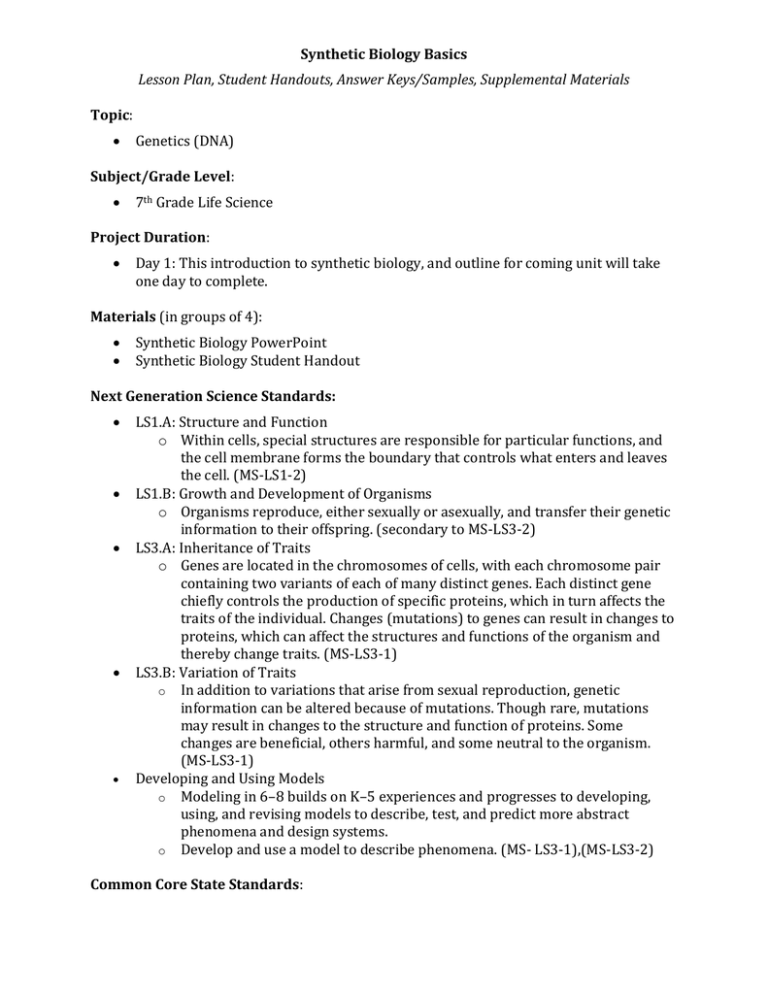
Synthetic Biology Basics Lesson Plan, Student Handouts, Answer Keys/Samples, Supplemental Materials Topic: Genetics (DNA) Subject/Grade Level: 7th Grade Life Science Project Duration: Day 1: This introduction to synthetic biology, and outline for coming unit will take one day to complete. Materials (in groups of 4): Synthetic Biology PowerPoint Synthetic Biology Student Handout Next Generation Science Standards: LS1.A: Structure and Function o Within cells, special structures are responsible for particular functions, and the cell membrane forms the boundary that controls what enters and leaves the cell. (MS-LS1-2) LS1.B: Growth and Development of Organisms o Organisms reproduce, either sexually or asexually, and transfer their genetic information to their offspring. (secondary to MS-LS3-2) LS3.A: Inheritance of Traits o Genes are located in the chromosomes of cells, with each chromosome pair containing two variants of each of many distinct genes. Each distinct gene chiefly controls the production of specific proteins, which in turn affects the traits of the individual. Changes (mutations) to genes can result in changes to proteins, which can affect the structures and functions of the organism and thereby change traits. (MS-LS3-1) LS3.B: Variation of Traits o In addition to variations that arise from sexual reproduction, genetic information can be altered because of mutations. Though rare, mutations may result in changes to the structure and function of proteins. Some changes are beneficial, others harmful, and some neutral to the organism. (MS-LS3-1) Developing and Using Models o Modeling in 6–8 builds on K–5 experiences and progresses to developing, using, and revising models to describe, test, and predict more abstract phenomena and design systems. o Develop and use a model to describe phenomena. (MS- LS3-1),(MS-LS3-2) Common Core State Standards: Speaking & Listening o Engage effectively in a range of collaborative discussions (one-on-one, in groups, and teacher- led) with diverse partners on grade 7 topics, texts, and issues, building on others’ ideas and expressing their own clearly. Learning Objectives: Students will be able to identify 4 uses of synthetic biology Students will be able to define the terms plasmid and enzyme Background Information: Plasmid: Bacterial in origin, extra-chromosomal, circular, double-stranded DNA, much smaller than the genome A substance produced by a living organism that acts as a catalyst to bring about a specific biochemical reaction Process of engineering recombinant DNA (simplified) Instructional Design: This lesson is largely teacher directed, but has points at which students are asked to discuss in small groups and then as a class. Hand out the note-taking guide to students and begin PowerPoint presentation. There are a number of slides towards the end where my RET research is illustrated. You can use or eliminate these slides, as it will not affect the content learned in the presentation. On the 5th slide you will find a YouTube video. It is a very nice explanation of synthetic biology and I recommend if you have time that you show it. Before advancing to the final slide, have students complete the “Reflection” question. This is a teaser to the final module where they will be debating the ethics of genetic engineering. Assessment: Students will be assessed on the following pieces: Completed notes 3-sentence summary of their feelings about genetic engineering
